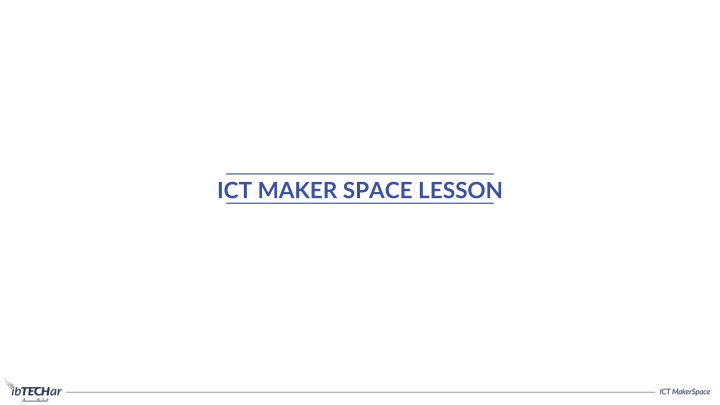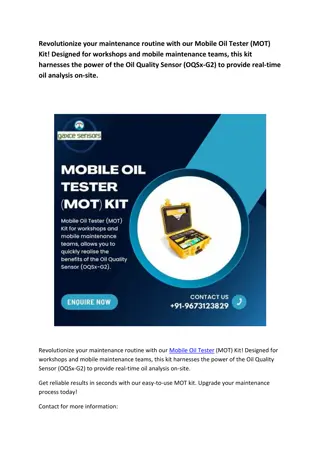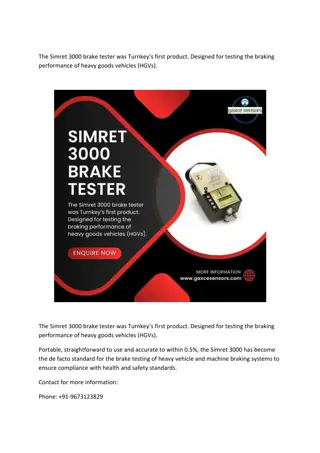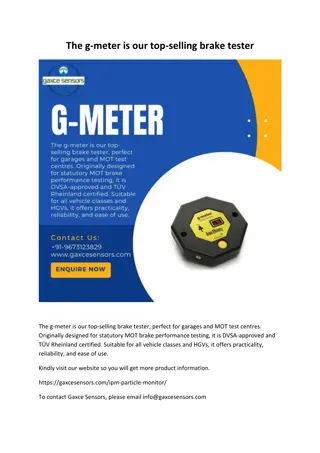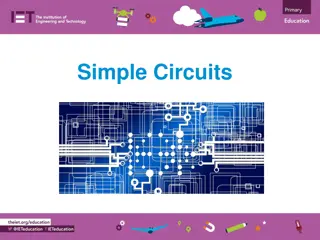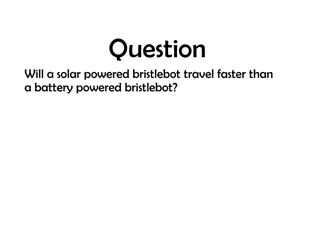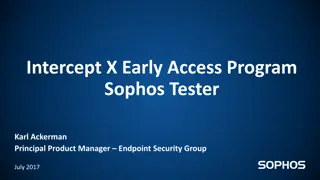Battery Tester Circuit Building and Programming Session
In this session, students will learn how to build a battery tester circuit and program it to display battery status using Arduino. The session includes an engineering design challenge where students create a portable meter. Learning objectives cover Arduino basics, battery cell functions, LED circuits, and voltage measurement. The lesson plan includes welcoming, client challenge brainstorming, introduction to electronics and microcontrollers, coding basics, and solution brainstorming. Students will engage in hands-on activities to develop their understanding of electronics and coding, culminating in designing their battery tester algorithm.
Download Presentation

Please find below an Image/Link to download the presentation.
The content on the website is provided AS IS for your information and personal use only. It may not be sold, licensed, or shared on other websites without obtaining consent from the author.If you encounter any issues during the download, it is possible that the publisher has removed the file from their server.
You are allowed to download the files provided on this website for personal or commercial use, subject to the condition that they are used lawfully. All files are the property of their respective owners.
The content on the website is provided AS IS for your information and personal use only. It may not be sold, licensed, or shared on other websites without obtaining consent from the author.
E N D
Presentation Transcript
SESSION TITLE: Battery Tester ZONE: Technology AGE GROUP: 11-14 DESCRIPTION: In this session students will build the circuit of a battery tester and learn how to program it to display the status of a battery using Arduino. ENGINEERING DESIGN CHALLENGE: Mohammed lives in a remote village and likes helping his father to collect and sell used electronic devices and batteries. He has a big box full of batteries but he needs a way to test whether they still provide power. He s seeking your help with providing him with an affordable and portable meter that he can use to test and display the status of the batteries he collects.
SESSION TITLE: Batter Tester LEARNING OBJECTIVES: After this session, students will be able to Describe Arduino, its features and applications. Explain how battery-cells function. Build a simple LED circuit. Program Arduino to measure the batteries voltage. EQUIPMENT: Electronic components, Microcontrollers, Batteries, Laptops.
LESSON PLAN (Pg. 1) Time / Duration Activity Materials Computer, internet access, projector/TV. 15 mins Welcoming & Introduction - Introduce yourself - Introduce students to the makerspace - Take the students on a tour around the space. - Present a project from each zone. 5 mins Design Challenge & Brainstorming: - Distribute the client letter. - Give students time to go through the letter and identify the challenge. [5 mins] - Discuss with students the challenge, design specifications and the best technology to solve the challenge. [5 mins] Projector or TV, Laptops, Client letter 5 mins Projector or TV, Laptops, Client letter Identify the Need to knows : - Ask students to identify the Need to knows independently to give them the choice to direct their own learning - Use the challenge constraints to guide and support the students through this step.
LESSON PLAN (Pg. 2) Time / Duration Activity Materials 15 mins Introduction to electronics & microcontrollers : - Introduce students to electricity & electronics. - Engage students in discussions. (What is electricity? How does flow? What are current & voltage? ) - Build a basic electric circuit - Explain microcontrollers to students and discuss its applications. Projector or TV Basic electronic components (Batteries, LED, wires, breadboards) Microcontrollers, Laptops 15 mins Introduce students to coding briefly: - Discuss the importance of coding and how is it used. - Explain the basics of Arduino coding Build a mini project with students using microcontrollers (e.g: blinking LED) Projector or TV Basic electronic components (Batteries, LED, wires, breadboards) Microcontrollers, Laptops 20 mins Brainstorm solutions to the challenge: - Discuss with students how can microcontrollers be used to solve the challenge. - Ask students to plan their final solution idea based on the client needs and constraints. Projector or TV Papers Pencils 10 mins - Guide students through developing an algorithm for the battery tester operation. Projector or TV Papers Pencils
LESSON PLAN (Pg. 3) Time / Duration Activity Materials 15 mins Build the solution: - Allow students to start trying to build the hardware part of the battery tester. - Provide students with hints and tips to help them build their solution. Projector or TV Basic electronic components (Batteries, LED, wires, breadboards) Microcontrollers, Laptops 15 mins Code the solution : - Ask students to start writing their code based on the algorithm they developed. - Check with students their codes and allow them to try and debug the errors independently. - Test and troubleshoot the final prototype. Projector or TV Basic electronic components (Batteries, LED, wires, breadboards) Microcontrollers, Laptops Computer, internet access, projector/TV. 5 mins Ask participants to present their final solutions
